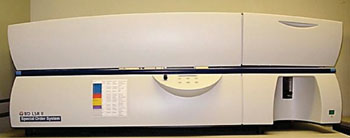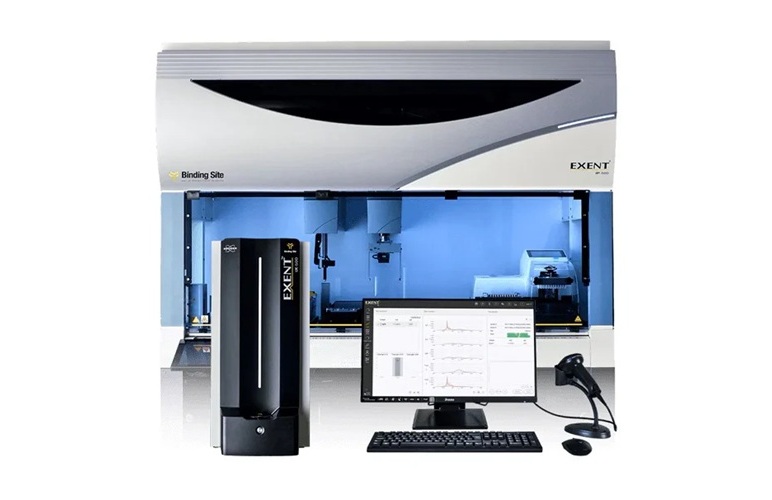Circulating Immune Cells Act As Idiopathic Pulmonary Fibrosis Biomarkers
|
By LabMedica International staff writers Posted on 14 Sep 2016 |

Image: The BD LSRII flow cytometer (Photo courtesy of Becton Dickinson).
Patients with fibrotic lung diseases, such as idiopathic pulmonary fibrosis (IPF), show progressive worsening of lung function with increased shortness of breath and dry cough.
To-date, this process is irreversible, which is why scientists are searching for novel biomarkers or indicators, which enable earlier diagnosis of this disease, with the aim to better interfere with disease progression.
Scientists at the Helmholtz Zentrum München (Munich, Germany) prospectively included 170 patients in the analysis, divided into 69 IPF, 56 non-IPF interstitial lung disease (ILD), 17 with hypersensitivity pneumonitis, 27 with nonspecific interstitial pneumonia, 12 with connective tissue disease- (ILD), and 23 chronic obstructive pulmonary disease (COPD) patients, as well as 22 healthy controls.
For immunophenotyping, the team collected fresh venous blood in EDTA-coated vacutainer tubes. Briefly, whole blood or peripheral blood mononuclear cell (PBMC) buffy coats were used for flow cytometry detection of myeloid-derived suppressor cells (MDSC) and lymphocyte subtypes. Erythrocytes were lysed with a Coulter Q-Prep working station (Beckman Coulter, Brea, CA, USA). Data acquisition was performed in a BD LSRII flow cytometer or a BD fluorescence-activated cell sorter (FACS) ARIA II (Becton Dickinson, Heidelberg, Germany) if cells were sorted. The T-cell suppression assay and MDSC co-cultures were also performed.
Peripheral blood mononuclear cell (PBMC) Messenger ribonucleic acid (mRNA) levels were analyzed by real time polymerase chain reaction (qRT-PCR). The investigators detected increased MDSC in IPF and non-IPF ILD compared with controls (30.99 ± 15.61% versus 18.96 ± 8.17%). Circulating MDSC inversely correlated with maximum vital capacity in IPF, but not in COPD or non-IPF ILD. MDSC suppressed autologous T-cells. The mRNA levels of co-stimulatory T-cell signals were significantly downregulated in IPF PBMC. Importantly, CD33+CD11b+ cells, suggestive of MDSC, were detected in fibrotic niches of IPF lungs.
Oliver Eickelberg, MD, a professor and lead investigator said, “We were able to show that MDSC are primarily found in fibrotic niches of IPF lungs characterized by increased interstitial tissue and scarring, that is, in regions where the disease is very pronounced, and as a next step, we seek to investigate whether the presence of MDSC can serve as a biomarker to detect IPF and to determine how pronounced it is. Controlling accumulation or expansion of MDSC or blocking their suppressive functions may represent a promising treatment options for patients with IPF. ” The study was published on September 1, 2016, in the European Respiratory Journal.
Related Links:
Helmholtz Zentrum München
Beckman Coulter
Becton Dickinson
To-date, this process is irreversible, which is why scientists are searching for novel biomarkers or indicators, which enable earlier diagnosis of this disease, with the aim to better interfere with disease progression.
Scientists at the Helmholtz Zentrum München (Munich, Germany) prospectively included 170 patients in the analysis, divided into 69 IPF, 56 non-IPF interstitial lung disease (ILD), 17 with hypersensitivity pneumonitis, 27 with nonspecific interstitial pneumonia, 12 with connective tissue disease- (ILD), and 23 chronic obstructive pulmonary disease (COPD) patients, as well as 22 healthy controls.
For immunophenotyping, the team collected fresh venous blood in EDTA-coated vacutainer tubes. Briefly, whole blood or peripheral blood mononuclear cell (PBMC) buffy coats were used for flow cytometry detection of myeloid-derived suppressor cells (MDSC) and lymphocyte subtypes. Erythrocytes were lysed with a Coulter Q-Prep working station (Beckman Coulter, Brea, CA, USA). Data acquisition was performed in a BD LSRII flow cytometer or a BD fluorescence-activated cell sorter (FACS) ARIA II (Becton Dickinson, Heidelberg, Germany) if cells were sorted. The T-cell suppression assay and MDSC co-cultures were also performed.
Peripheral blood mononuclear cell (PBMC) Messenger ribonucleic acid (mRNA) levels were analyzed by real time polymerase chain reaction (qRT-PCR). The investigators detected increased MDSC in IPF and non-IPF ILD compared with controls (30.99 ± 15.61% versus 18.96 ± 8.17%). Circulating MDSC inversely correlated with maximum vital capacity in IPF, but not in COPD or non-IPF ILD. MDSC suppressed autologous T-cells. The mRNA levels of co-stimulatory T-cell signals were significantly downregulated in IPF PBMC. Importantly, CD33+CD11b+ cells, suggestive of MDSC, were detected in fibrotic niches of IPF lungs.
Oliver Eickelberg, MD, a professor and lead investigator said, “We were able to show that MDSC are primarily found in fibrotic niches of IPF lungs characterized by increased interstitial tissue and scarring, that is, in regions where the disease is very pronounced, and as a next step, we seek to investigate whether the presence of MDSC can serve as a biomarker to detect IPF and to determine how pronounced it is. Controlling accumulation or expansion of MDSC or blocking their suppressive functions may represent a promising treatment options for patients with IPF. ” The study was published on September 1, 2016, in the European Respiratory Journal.
Related Links:
Helmholtz Zentrum München
Beckman Coulter
Becton Dickinson
Latest Pathology News
- AI Tool Outperforms Doctors in Spotting Blood Cell Abnormalities
- AI Tool Rapidly Analyzes Complex Cancer Images for Personalized Treatment
- Diagnostic Technology Performs Rapid Biofluid Analysis Using Single Droplet
- Novel Technology Tracks Hidden Cancer Cells Faster
- AI Tool Improves Breast Cancer Detection
- AI Tool Predicts Treatment Success in Rectal Cancer Patients
- Blood Test and Sputum Analysis Predict Acute COPD Exacerbation
- AI Tool to Transform Skin Cancer Detection with Near-Perfect Accuracy
- Unique Immune Signatures Distinguish Rare Autoimmune Condition from Multiple Sclerosis
- Simple Optical Microscopy Method Reveals Hidden Structures in Remarkable Detail
- Hydrogel-Based Technology Isolates Extracellular Vesicles for Early Disease Diagnosis
- AI Tool Improves Accuracy of Skin Cancer Detection
- Highly Sensitive Imaging Technique Detects Myelin Damage
- 3D Genome Mapping Tool to Improve Diagnosis and Treatment of Genetic Diseases
- New Molecular Analysis Tool to Improve Disease Diagnosis
- Tears Offer Noninvasive Alternative for Diagnosing Neurodegenerative Diseases
Channels
Clinical Chemistry
view channel
Chemical Imaging Probe Could Track and Treat Prostate Cancer
Prostate cancer remains a leading cause of illness and death among men, with many patients eventually developing resistance to standard hormone-blocking therapies. These drugs often lose effectiveness... Read more
Mismatch Between Two Common Kidney Function Tests Indicates Serious Health Problems
Creatinine has long been the standard for measuring kidney filtration, while cystatin C — a protein produced by all human cells — has been recommended as a complementary marker because it is influenced... Read moreMolecular Diagnostics
view channel
First-Of-Its-Kind Automated System Speeds Myeloma Diagnosis
More than 176,000 people are diagnosed with multiple myeloma worldwide each year, yet the current diagnostic pathway can be slow and uncertain, often relying on a highly subjective interpretation of test results.... Read more
Blood Protein Profiles Predict Mortality Risk for Earlier Medical Intervention
Elevated levels of specific proteins in the blood can signal increased risk of mortality, according to new evidence showing that five proteins involved in cancer, inflammation, and cell regulation strongly... Read moreHematology
view channel
Platelet Activity Blood Test in Middle Age Could Identify Early Alzheimer’s Risk
Early detection of Alzheimer’s disease remains one of the biggest unmet needs in neurology, particularly because the biological changes underlying the disorder begin decades before memory symptoms appear.... Read more
Microvesicles Measurement Could Detect Vascular Injury in Sickle Cell Disease Patients
Assessing disease severity in sickle cell disease (SCD) remains challenging, especially when trying to predict hemolysis, vascular injury, and risk of complications such as vaso-occlusive crises.... Read more
ADLM’s New Coagulation Testing Guidance to Improve Care for Patients on Blood Thinners
Direct oral anticoagulants (DOACs) are one of the most common types of blood thinners. Patients take them to prevent a host of complications that could arise from blood clotting, including stroke, deep... Read moreMicrobiology
view channel
Rapid Assay Identifies Bloodstream Infection Pathogens Directly from Patient Samples
Bloodstream infections in sepsis progress quickly and demand rapid, precise diagnosis. Current blood-culture methods often take one to five days to identify the pathogen, leaving clinicians to treat blindly... Read more
Blood-Based Molecular Signatures to Enable Rapid EPTB Diagnosis
Extrapulmonary tuberculosis (EPTB) remains difficult to diagnose and treat because it spreads beyond the lungs and lacks easily accessible biomarkers. Despite TB infecting 10 million people yearly, the... Read more
15-Minute Blood Test Diagnoses Life-Threatening Infections in Children
Distinguishing minor childhood illnesses from potentially life-threatening infections such as sepsis or meningitis remains a major challenge in emergency care. Traditional tests can take hours, leaving... Read more
High-Throughput Enteric Panels Detect Multiple GI Bacterial Infections from Single Stool Swab Sample
Gastrointestinal (GI) infections are among the most common causes of illness worldwide, leading to over 1.7 million deaths annually and placing a heavy burden on healthcare systems. Conventional diagnostic... Read morePathology
view channel
AI Tool Outperforms Doctors in Spotting Blood Cell Abnormalities
Diagnosing blood disorders depends on recognizing subtle abnormalities in cell size, shape, and structure, yet this process is slow, subjective, and requires years of expert training. Even specialists... Read more
AI Tool Rapidly Analyzes Complex Cancer Images for Personalized Treatment
Complex digital biopsy images that typically take an expert pathologist up to 20 minutes to assess can now be analyzed in about one minute using a new artificial intelligence (AI) tool. The technology... Read moreTechnology
view channel
AI Saliva Sensor Enables Early Detection of Head and Neck Cancer
Early detection of head and neck cancer remains difficult because the disease produces few or no symptoms in its earliest stages, and lesions often lie deep within the head or neck, where biopsy or endoscopy... Read more
AI-Powered Biosensor Technology to Enable Breath Test for Lung Cancer Detection
Detecting lung cancer early remains one of the biggest challenges in oncology, largely because current tools are invasive, expensive, or unable to identify the disease in its earliest phases.... Read moreIndustry
view channel
Abbott Acquires Cancer-Screening Company Exact Sciences
Abbott (Abbott Park, IL, USA) has entered into a definitive agreement to acquire Exact Sciences (Madison, WI, USA), enabling it to enter and lead in fast-growing cancer diagnostics segments.... Read more






















